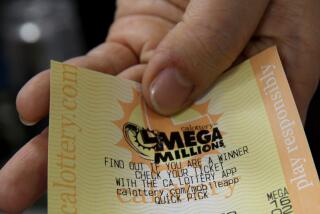‘Green Machines’ to Raise Stakes for Lottery Players
- Share via
PROVIDENCE, R.I. — They’re known as the “Green Machines.”
They’re about 16 inches wide, 18 inches long and 13 inches tall, with dots on top that serve as push-buttons. There should be 5,000 of them in California by midsummer, and another 7,000 of them may show up after that, so you’ll probably get used to them.
They’re the countertop computer terminals a Rhode Island firm here called GTECH Corp. will be installing in retail outlets throughout the state for use in the California Lottery’s upcoming Lotto games--a legalized form of the numbers games that have been run illegally for decades.
Until now, Californians playing their state lottery have had to make do with so-called “instant games,” which started up last fall and enjoyed immediate success, with sales that so far have totaled more than $1 billion.
The Lotto games--scheduled to start sometime this summer and expected to do even better--will differ from the instant games in several respects.
In the instant games, participants buy preprinted tickets at any of about 20,000 retail outlets in California. Purchasers scratch off an opaque film covering six symbols on each ticket to see if there are any winning combinations. In most cases, the dollar value of the winning combination is indicated by the symbols.
Instant games are considered “passive,” because the purchaser has no control over what the printed combination will be.
In the Lotto games, participants can place bets--selecting their own numbers--wherever a Green Machine is installed. Most of them probably will be at retail outlets that have enjoyed the greatest success with the instant games.
Lotto players probably will have two methods of making a bet--marking six of about 40 numbers on a preprinted IBM-type card, which is then inserted into the Green Machine, or telling a clerk which numbers you want him to punch into the machine, using the push-buttons.
Frequent Drawings
In either case, the numbers selected and an identification code will be recorded at one of the two computer centers. The Green Machine will then spit out a receipt printed with the numbers selected, the time, the date and the place of purchase.
Chances to win big at Lotto will occur frequently, with drawings of some sort scheduled weekly or even daily to determine the winning combinations. To claim their prizes, winners will present their receipts.
Unlike the instant games, in which the payoffs are largely predetermined, the size of the Lotto prizes will be determined by the number of people who buy tickets.
If no one picks all six numbers, the top prize will be “rolled over” to the next game. Lotto roll-overs in New York during the last seven months have led to grand prizes of $30 million and $41 million--the largest lottery payoffs in North American history. The top prize in California’s instant games so far has been $6.3 million.
Active Role for Player
The Lotto games thus have two features that have made them even more popular than the instant games. Lotto offers players an active role, permitting them to choose the numbers--often anniversary dates or other favorites--that could turn out to be winners. And because of the pricing structure, Lotto roll-overs climb faster than in the instant games.
“Lotto appeals to the BMW crowd, because it’s real money,” said John Jervis, a public relations executive representing GTECH in California. “It’s going to bring in a lot more people.”
GTECH is gearing up operations at its 150,000-square-foot production plant in Warwick, a suburb nine miles southwest of Providence, to get the California Lotto system into operation by midsummer--a deadline that both Robert Stern, the firm’s chairman, and Mark Michalko, California’s lottery director, are confident will be met.
Stern said the firm’s current total of about 800 employees will be increased to more than 1,100 by then, with 200 of them in California, probably under the direction of Roy Golic, who currently heads the firm’s lottery operations for the state of New Jersey.
Cushioned Trip
Green Machines built at Warwick will be hauled to California in specially cushioned trucks, then stored at field-service depots in the Sacramento, San Diego and Whittier areas until they can be installed.
GTECH’s computer centers are being built in Whittier and Sacramento, using equipment supplied by Perkin-Elmer Corp. of Norwalk, Conn.
Stern said either center will have the capacity to handle the entire statewide load, at least during the first few years of what is expected to be a steadily growing operation.
The terminals will be tied to the computers through a network of secure communication lines leased from Pacific Telephone, General Telephone Co. and MCI.


